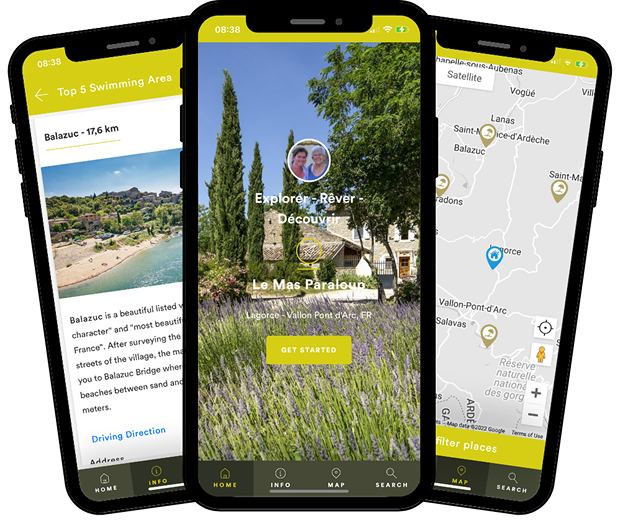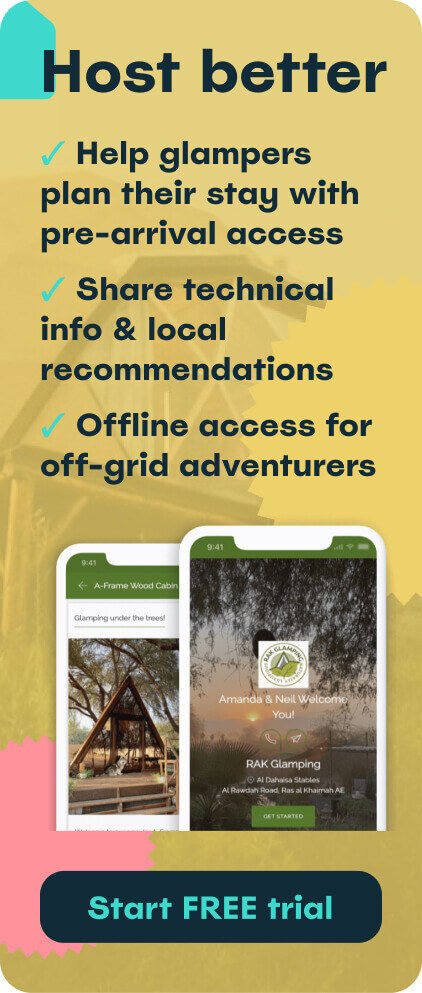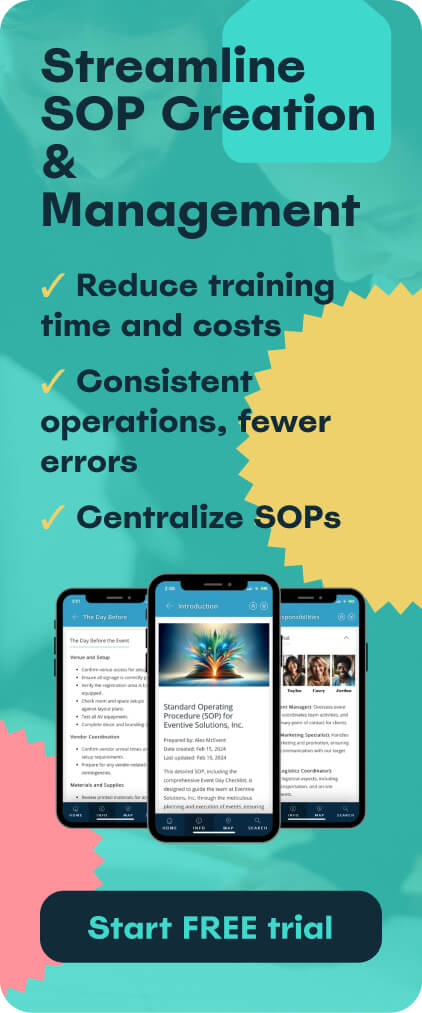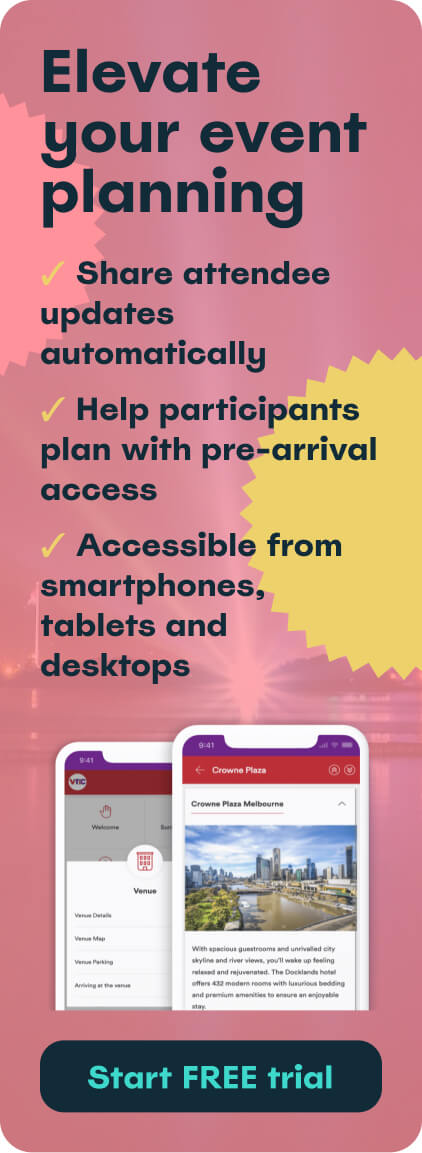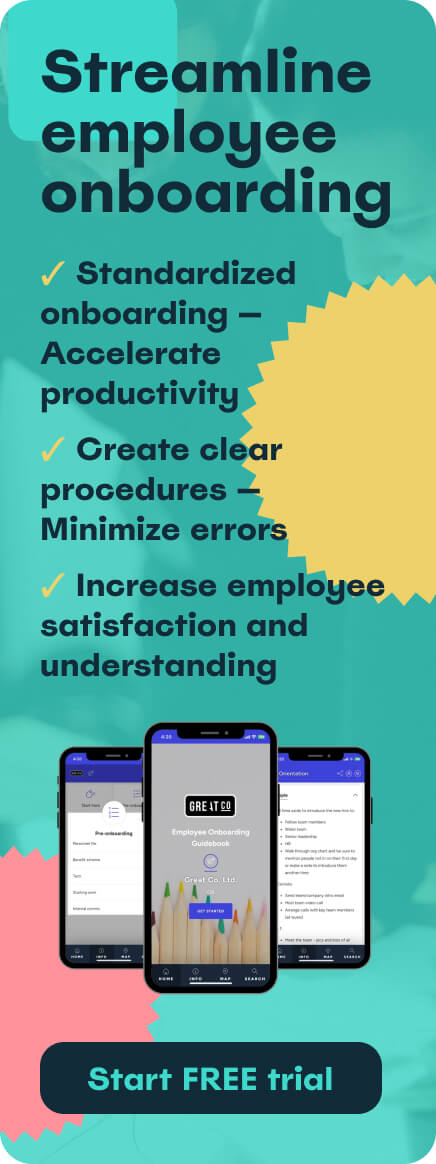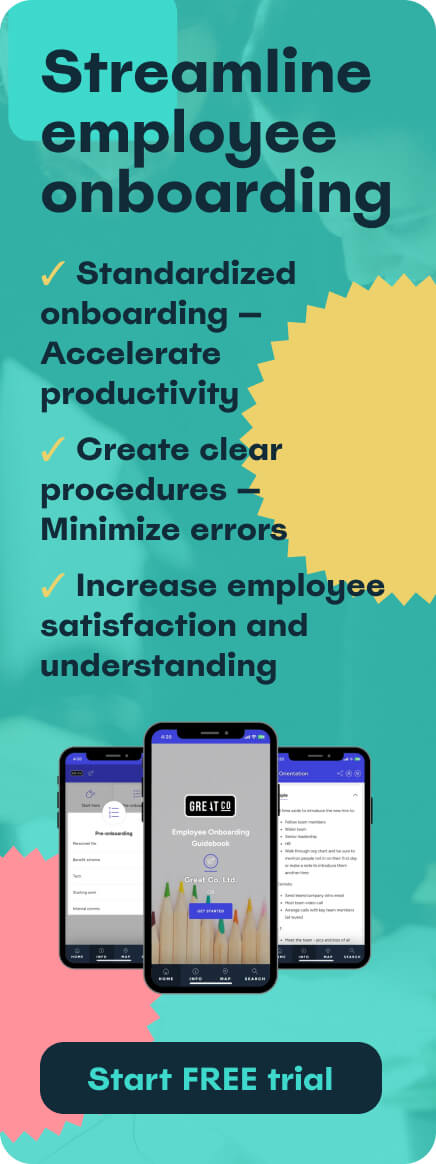Remote hiring is now standard for many teams, but helping someone settle in from another city or country can still feel tricky. Without an office tour or hallway chats, you need a plan that makes new hires feel supported, gives them clarity about their role, and helps them start contributing with confidence.
To give you and your new employees the best start possible, we’ve made a guide that breaks down what effective remote onboarding looks like today from planning the first week to setting milestones and building lasting team connections.
Key takeaways
- Map out a clear 30/60/90-day onboarding plan so new hires know what success looks like
- Use video calls and virtual intros to build trust and human connection early
- Share role-specific training materials before day one to remove first-week friction
- Standardize onboarding across teams to create a consistent experience for everyone
- Create a centralized onboarding hub where new hires can find policies, checklists, and key contacts anytime
Jump to a section:
- What is remote employee onboarding?
- Why remote onboarding matters
- Why is it often better to hire remote employees?
- How long should remote onboarding take?
- How to virtually onboard remote employees
- Virtual onboarding checklist & schedule
- Common remote onboarding challenges
- How to manage onboarding new hires remotely
- 15 tips for remote employee onboarding
- Final thoughts
- Frequently Asked Questions
Ready to make onboarding easier for everyone? Try Touch Stay free for 14 days and build a guide your new hires will actually use.
What is remote employee onboarding?
Remote employee onboarding is the process of integrating new hires into your team when they’re working from a different location, often from home or another city, state, or country.
A thoughtful remote onboarding process helps new employees feel connected, confident, and productive from day one. It requires a more intentional approach than in-person onboarding, especially around communication, resources, and team engagement.
Here are the core components of an effective remote onboarding process.
Core components of remote onboarding

Remote onboarding includes many of the same elements as in-person onboarding, but they’re delivered digitally. Here are the essentials:
- Preboarding: Before the official start date, new hires receive welcome emails, digital paperwork, and equipment shipments.
- Orientation: The first few days focus on company values, team introductions, and tool setup, often through video calls, recorded sessions, and interactive documents.
- Training and ramp-up: Provide job-specific training, shadowing opportunities, and regular check-ins as new hires start contributing.
- Relationship building: Replace hallway chats with structured connection points like virtual coffee chats, Slack channels, and buddy programs.
Strong relationship-building efforts are what prevent remote hires from feeling isolated.
Why remote onboarding matters
Remote onboarding sets expectations, builds trust, and helps new hires feel confident in their roles without ever stepping into a physical office.
Here’s why it deserves extra attention, especially as distributed teams become the norm.
It sets the tone for employee engagement and retention

The first few weeks shape how new hires feel about your company long term. A disorganized or impersonal experience can leave remote employees feeling disconnected and even increase the risk of early turnover.
Research from Glassdoor shows a strong onboarding process can boost retention by 82% and productivity by over 70%. It also helps employees feel more engaged and shortens time-to-productivity, both of which benefit managers and the wider team.
A well-structured remote onboarding process helps:
- Build early momentum with clear goals and timelines
- Reduce anxiety through consistent communication and support
- Reinforce company culture, even without in-person interactions
- Speed up contributions by giving employees the resources they need upfront
Simple touches make a difference, like a welcome video from the CEO or pairing new hires with a buddy for casual check-ins. These human moments help new team members build trust from day one.
It reduces repetitive questions and support requests
Remote new hires can’t just lean over to ask a quick question. Without a clear onboarding hub, managers get buried in Slack pings, emails, and last-minute meeting requests.
A centralized digital guide solves this by giving employees everything they need in one place: workflows, policies, tool setup instructions, and answers to FAQs. This way, managers can focus on higher-value work instead of repeating the same steps for every hire.
For example, your guide might include:
- How to request time off
- How to set up email signatures and communication tools
- Who to contact for IT, HR, or approvals
Tools like Touch Stay make this easy to set up and share, so information stays organized and up to date.
Want to see what a great onboarding guide looks like? Check out our list of employee onboarding examples and borrow ideas for your own.
It supports consistent onboarding across roles and locations
Remote onboarding makes it easier to create a consistent, repeatable process. Every new hire (whether they’re in marketing, engineering, or support) gets the same clear information and support from day one.
Standardized onboarding helps:
- Prevent knowledge gaps between teams or regions
- Scale hiring without reinventing the process
- Keep compliance and training easy to track
You can even automate reminders for key steps, like completing benefits enrollment or joining a training session, to keep everything moving smoothly.
Consistency pays off: studies show employees are 50% more productive when onboarding is structured and standardized.
When onboarding is consistent, your whole team benefits: fewer gaps, faster ramp-up, and better collaboration across time zones.
Why is it often better to hire remote employees?
Hiring remotely isn’t just a trend. It’s a way to unlock financial, operational, and team benefits. Here are four standout advantages:
Access to global talent
When geography isn't a limitation, you can hire the best person for the role, not just the best person in your ZIP code. This widens your candidate pool dramatically and makes it easier to find specialized skills.
Many companies also report higher employee engagement among remote hires: 31% of remote professionals say they feel more engaged compared to 19% of in-office workers.
If you're hiring remote employees across borders, an Employer of Record (EOR) can simplify compliance, payroll, and onboarding in different countries. For instance, companies hiring in Canada can use an EOR provider like Rippling to handle the local requirements.
Lower overhead costs
Remote work can significantly reduce fixed costs. Companies save an average of USD $11,000 per employee per year by cutting rent, utilities, and office supplies.
Those savings can be reinvested into growth initiatives like marketing, technology upgrades, or improving employee experience.
Greater flexibility and diversity
Hiring across regions means better coverage across time zones and a team with more diverse backgrounds and perspectives. This diversity often leads to more creative solutions and improved innovation.It also helps businesses stay resilient. With a remote team, operations can continue uninterrupted during local disruptions or office closures.
Scalability for fast-growing businesses
Scaling is easier when you’re not tied to physical space. Need to bring on seasonal help or expand a department quickly? You can hire from anywhere without worrying about relocation packages or adding office desks.
Some studies suggest companies that embrace remote-first hiring can onboard new employees 25% faster due to simplified logistics and standardized processes.
How long should remote onboarding take?
Remote onboarding works best as a phased process rather than a single-day orientation. Most companies use a 30-60-90 day plan to balance learning, contribution, and independence.
|
Phase |
Focus |
Goals |
|
First 30 days |
Introductions, company culture, basic tools |
Help the new hire feel connected and comfortable |
|
Next 30 days |
Role-specific training and hands-on tasks |
Start contributing to projects with close manager support |
|
Final 30 days |
Independence and performance goals |
Work confidently, meet targets, and plan future growth |
A phased approach sets clear milestones, gives managers a framework for check-ins, and prevents new hires from feeling overwhelmed.

Onboarding materials for remote employees
When onboarding remotely, your materials do most of the heavy lifting. Without in-person walkthroughs, new hires rely on clear, accessible documentation to get started confidently.
Start with a centralized onboarding hub
Remote employees shouldn’t have to dig through emails, Slack threads, or random folders to find what they need. Create one easy-to-navigate hub where all onboarding resources live.
This could be a Notion workspace, a Google Site, a Touch Stay guide, or a dedicated folder in your knowledge base. The key is that it’s:
- Easy to access from day one
- Clearly organized by topic or timeline
- Kept up to date by an owner
At a minimum, include:
- Welcome message from leadership
- Company mission, values, and culture guide
- Org chart and contact info
- First-week schedule and key meetings
- Tool setup instructions (Slack, email, project management)
- Role-specific onboarding checklist
- HR policies (security, time off, benefits)
Tip: If you’re using a digital guidebook or onboarding platform, link directly to the relevant pages so employees can find what they need in a click.
Include role-specific training and documentation
General company information is helpful, but role-specific content is what helps new hires start contributing faster and avoid early burnout.
For each role, prepare:
- A list of tools and logins specific to their job
- Video walkthroughs or screen recordings of key workflows
- A glossary of internal terms and acronyms
- Sample projects or deliverables
- A clear 30-60-90 day plan with milestones
For example, a remote support rep might get a help desk guide, saved replies, and shadowing sessions with senior team members.
Make it interactive and easy to update
Static PDFs and slide decks can quickly go stale. Remote onboarding materials work best when they’re engaging, trackable, and easy to refresh.
Ideas to improve usability:
- Use short videos or GIFs to show workflows visually
- Embed quizzes or checklists to reinforce learning
- Add feedback forms for questions and clarity
- Track engagement with link analytics or completion checkmarks
Tools like Loom or Scribe make this easy to build and maintain so your onboarding hub stays useful as your company grows.
As you build out your materials, think about how they’ll support your virtual onboarding process. We’ll cover that next.
How to virtually onboard remote employees
A good remote onboarding experience doesn’t happen by accident. It’s planned and phased. Here’s how to guide new hires through each stage:
Pre-boarding (before day one)
Set your new hire up for success before they ever log in:
- Send offer letter, contract, and required paperwork digitally
- Ship company equipment so it’s ready on day one
- Share your onboarding hub or guide with welcome messages, policies, and a “what to expect” checklist
Day one essentials
Keep the first day simple and focused:
- Host a virtual welcome meeting and introduce key team members
- Walk through basic tools like email, chat apps, and project management software
- Show them where to find your onboarding hub so they can revisit policies and contacts anytime
Week one integration
Help new hires settle in and start building relationships:
- Pair them with a buddy or mentor for informal support
- Schedule regular check-ins with their manager
- Cover company culture, communication norms, and workflows
- Encourage questions and point them back to the central guide for reference
First 30/60/90 days
Give new hires clear milestones so they can track progress and build confidence:
- 30 days: Understand company culture, complete training modules, contribute to a small project
- 60 days: Take ownership of core responsibilities with light oversight
- 90 days: Work independently, hit performance targets, and plan next steps with their manager
Tracking progress inside your Touch Stay guide keeps everyone aligned and makes sure nothing slips through the cracks.
Virtual onboarding checklist & schedule
A clear checklist and schedule help you stay organized, avoid last-minute scrambles, and give new hires a smooth, structured experience.
What to include in your virtual onboarding checklist
Break it into four categories so nothing gets missed:
Pre-boarding (before day one):
- Send welcome email with start date, schedule, and key contacts
- Ship equipment (laptop, monitor, headset, etc.)
- Provide logins for email, tools, and communication platforms
- Share employee handbook and company policies
- Invite them to your onboarding hub
First day:
- Host a welcome call or video meeting
- Walk through the onboarding hub or portal
- Introduce their manager and onboarding buddy
- Review first-week schedule
- Confirm tool access and fix any tech issues
First week:
- Schedule team introductions (1:1s or group calls)
- Assign training modules or resources
- Set up recurring check-ins with manager
- Cover company values, mission, and workflows
- Encourage questions and feedback
First 30 days:
- Begin role-specific training or shadowing
- Assign a small project
- Review performance goals and expectations
- Hold a 30-day check-in to review progress
Use a shared checklist tool or project management board (like Trello, Notion, or Asana) to track progress. Give both the new hire and their manager visibility so nothing slips through the cracks.
Sample onboarding schedule by week
A structured schedule helps new hires pace themselves and gives managers a clear view of progress. Here’s a sample four-week onboarding schedule for a remote customer support role:
|
Week |
Focus Areas |
Activities |
|---|---|---|
|
1 |
Orientation & Tools |
Welcome call, tool setup, intro meetings, company overview |
|
2 |
Training & Shadowing |
Product training, support platform walkthrough, shadowing live calls |
|
3 |
Practice & Feedback |
Handle low-risk tickets, daily feedback sessions, knowledge checks |
|
4 |
Independent Work |
Manage full ticket queue, weekly check-in, 30-day review |
Adjust timing based on role complexity. For example, a software engineer may need more time for codebase walkthroughs, while a marketing hire might start contributing sooner.
With your checklist and schedule in place, you’ll be better prepared to handle the common remote onboarding challenges we’ll cover next.
Want a more detailed breakdown of what to include in your onboarding? Check out our full onboarding checklist for more.
Common remote onboarding challenges
Remote onboarding has become more common, but that doesn’t mean it’s always smooth. Without in-person interaction, it’s easier for new hires to feel disconnected, confused, or overwhelmed. Even experienced managers can struggle to replicate the structure and support of an on-site onboarding process.
These are some of the most common challenges teams face when onboarding remote employees and practical ways to address them.
Lack of clarity and structure
When onboarding lives in scattered docs, Slack threads, and ad-hoc calls, new hires feel lost and managers end up repeating themselves.
|
Signs |
How to fix it |
Example |
|
Repeated questions about tools, policies, or contacts |
Publish a step-by-step onboarding plan (week 1, week 2, 30/60/90) in a single hub |
A single “Start here” page links to tool setup, first-week schedule, key contacts, and policies |
|
Missed meetings or deadlines |
Track progress in a shared board visible to the hire and manager |
Managers can quickly see what’s done and follow up where needed |
|
Confusion about who owns what |
Schedule short, regular check-ins during the first two weeks |
15-minute stand-ups help projects run smoothly |
Limited connection with team and culture
Without casual desk chats or lunches, new hires can feel like outsiders even after weeks on the job.
|
Signs |
How to fix it |
Example |
|
Low engagement in meetings or chat channels |
Schedule intentional introductions with manager, buddy, and cross-functional peers during week one |
Add short 1:1 “get-to-know-you” calls to the first-week schedule |
|
Few social interactions |
Create a light “first 30 days culture calendar” with prompts like “join the #social channel” or “share a fun intro post” |
Send a Slack prompt each week with a simple activity to try |
|
Difficulty building cross-team relationships |
Share a short culture guide with values, communication norms, and meeting etiquette |
Include fun facts about team rituals (Friday wins, monthly virtual catch-up, etc.) |
Overloading or underloading new hires
New hires either get overwhelmed by too much information or sit idle waiting for direction.
|
Signs |
How to fix it |
Example |
|
Stress or confusion about priorities |
Use a “learn → shadow → do” sequence to pace onboarding |
Week 1 = observe, week 2 = practice with guidance, week 3 = take ownership |
|
Long gaps between tasks or meetings |
Break training into 15-30 minute modules with one action each |
Turn a 60-page handbook into short searchable pages or videos |
|
Managers unsure how much is being absorbed |
Set 2-3 weekly priorities and review them in a standing 1:1 |
Use a shared checklist and tick items off together during check-ins |
Time zones and scheduling friction
Distributed teams often face delays, meeting fatigue, and blocked work due to time zone gaps.
|
Signs |
How to fix it |
Example |
|
Slow feedback loops |
Default to async workflows with clear briefs and recorded Loom demos |
Record a 3-minute explainer instead of scheduling a meeting |
|
Meeting fatigue across time zones |
Set overlapping “core hours” for live collaboration |
Schedule all-hands during the 2-3 hour overlap window |
|
Blocked tasks overnight |
Reserve meetings for decisions and use written updates for status |
Post updates in project boards or Slack so progress continues while others sleep |
Understanding these common challenges is the first step toward designing a smoother experience. In the next section, we’ll look at how to manage onboarding new hires remotely.
How to manage onboarding new hires remotely
Remote onboarding isn’t just about sending a welcome email, it’s an ongoing process that needs structure, communication, and the right tools. Here’s how to manage it effectively.
Build regular touchpoints
Consistent interaction keeps new hires engaged and prevents them from feeling adrift.
- Daily check-ins in week one: Short 15-minute standups help answer questions early.
- Weekly 1:1s for the first 90 days: Use them to give feedback, review priorities, and adjust pacing.
- Peer meetups: Pair new hires with a buddy for casual chats and a go-to contact for small questions.
Ask open-ended questions during check-ins:
“What’s been unclear this week?”
“Is anything slowing you down?”
“What would help you feel more confident right now?”
Keep information visible and connected
Make it easy for new hires to find what they need without chasing down multiple people.
- Use a digital onboarding hub (like Touch Stay) to centralize resources.
- Track progress in a project management tool so everyone can see what’s completed.
- Create an onboarding Slack/Teams channel for quick questions and links.
The goal is to create a single source of truth and reduce the cognitive load for new hires so they can focus on learning, not hunting for information.
Managing remote onboarding well takes planning, but it pays off in faster ramp-up times and stronger team connections.
15 tips for remote employee onboarding
Remote onboarding doesn’t need to feel distant or overwhelming. These tips help you create an engaging, repeatable process that makes new hires feel supported from day one.
Before day one
- Ship equipment early: Deliver laptops, headsets, and any extras in time for setup before the first day.
- Send a digital welcome kit: Include a message from leadership, company values, and the first-week schedule.
- Give access to resources early: Share your onboarding hub so new hires can explore policies, team info, and what to expect.
- Set clear expectations: Outline working hours, communication norms, and response times upfront.
First-week experience
- Host a warm welcome call: Kick off with a group intro or all-hands to help them meet the team.
- Provide a virtual office tour: Show where to find tools, docs, and team spaces with a short Loom or screen-share video.
- Document unwritten rules: Cover Slack etiquette, meeting culture, and decision-making norms.
- Create social icebreakers: Use virtual coffee chats, quizzes, or “get to know you” Slack threads to spark casual connections.
Training and growth
- Use bite-sized training: Deliver 15-30 minute modules they can complete and revisit anytime.
- Offer interactive learning: Embed quizzes, clickable checklists, or micro-assignments to keep engagement high.
- Assign a starter project: Give a small, low-pressure task that lets them contribute quickly and build confidence.
- Provide a glossary: Share a quick reference of acronyms, tools, and internal jargon to cut confusion.
Long-term support
- Share a growth roadmap: Show what skills and milestones are expected at 30/60/90 days and beyond.
- Collect feedback regularly: Survey new hires at 30 and 90 days to see what worked and where to improve.
- Offer continued learning opportunities: Point them toward online courses, mentorship programs, or communities that align with their role.
With these tips in place, you’re sure to create a smooth and pleasant onboarding experience for all employees.
Final thoughts
Remote onboarding doesn’t have to be complicated, but it does need to be intentional. A thoughtful process builds trust, shortens ramp-up time, and helps new hires feel like part of the team no matter where they are.
The key is to make everything clear, consistent, and easy to find. When new hires know where to go for answers, they gain confidence faster and managers spend less time repeating the same instructions.
Touch Stay gives you one place to store everything, from welcome messages and policies to checklists and training videos, so new hires always know where to look.
Ready to build a smoother remote onboarding experience? Start your free 14-day trial and build an onboarding guide that helps every new hire succeed.
Frequently Asked Questions
Yes. With the right process and tools, remote onboarding can be just as effective as in-person onboarding. The key is to have a clear plan, provide easy access to information, and schedule regular check-ins so new hires don’t feel disconnected.
Most companies follow a phased approach:
- Pre-boarding: Send equipment, paperwork, and welcome materials before day one.
- Day one: Introduce the company, team, and basic tools.
- Week one: Focus on culture, workflows, and early contributions.
- 30/60/90 days: Build skills, set goals, and gradually move toward full independence.
The five C’s are a simple framework to guide onboarding: Compliance (forms and legal requirements), Clarification (role expectations), Culture (values and norms), Connection (building relationships), and Check-ins (ongoing support and feedback).
A good setup usually includes:
- Communication tools like Slack or Teams
- Video conferencing for face-to-face meetings
- Project management software like Asana or Trello
- Digital onboarding guides (like TouchStay) to store policies, checklists, and resources in one place
Track metrics like time-to-productivity, completion rates for training modules, and retention after 90 days. You can also send surveys to new hires asking about clarity, support, and overall experience. Their feedback is one of the best indicators of whether your process is working.

Laura Clayton
Laura Clayton is a copywriter with a BA in fiction writing from Columbia College Chicago. From holding a position as a background investigator retained by the United States government, to teaching English, and writing about real estate, Laura has a diverse and varied background. She has been writing for SaaS companies since 2019 in a wide range of industries.
Be the first to know!
Join our newsletter for early access to:
- ✅ Free guides
- ✅ Pro tips & tricks
- ✅ Time saving tutorials
- ✅ Latest blog posts
- ✅ Checklists & templates

